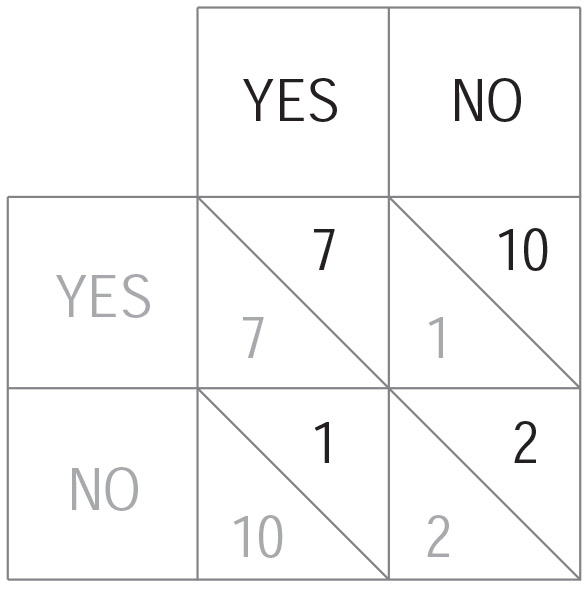Voting on a Verdict
Materials: Two charts of voting outcomes (see annex), a lot of small notes of equal size to serve as ballots, two flipchart papers to record the voting results
Exercise description
The participants are split into two groups of seven people and they work in separate spaces. Two or three people are observers in each group (depending on the total number of participants). Slowly and clearly read the story about the context for the exercise, at least twice.
Story:
“You are two rival humanitarian organisations working with children. Both your organisations currently work on multiple important projects planned for the upcoming two years (one of the main projects is procurement of aids for children with disabilities). One officer from each of the two organisations has been arrested for using the privileges given to humanitarian organisations for personal gain (evasion of customs taxes). Importing technical equipment was at issue. All the other employees (all of you) knew about this but turned a blind eye. The public prosecutor suspects that the two officers cooperated in these illegal activities.
You are faced with the question: Is your organisation guilty as a whole?
The group votes by secret ballot and the decision is made by simple majority vote.”
The two groups then go work in separate spaces. It is important that they are in different room so that they cannot overhear each other.
It is explained to each group that the outcome of the vote on whether they are guilty as an organisation will have different illustrates the different outcomes:

Possible voting outcomes:
- If both organisations admit their guilt, they will be banned from working for 7 months.
- If both organisations deny their guilt, they will be banned from working for two months.
- If one organisation admits to being guilty, but the other does not, the organisation that admitted its guilt will be banned from working for one month, and the organisation that did not will be banned from working for 10 months.
You can download the voting outcomes chart suitable for printing on A4 paper
Voting plan:
1st round: Everyone receives a ballot paper to enter their vote (“Guilty” or “Not Guilty”). Everyone votes individually, without consultations within the group. The trainer delivers the verdict based on the results of the vote on both groups (to each group) and the corresponding punishment, as well as specifically how the other group voted. She writes this on the chart on the flipchart paper.
Example chart for recording the votes:
Each group receives a copy of the chart.
2nd round: Voting takes place again without prior consultation and the results are given to both groups. Only then does each group get five minutes to confer and nominate a negotiator to go negotiate with the other group. After negotiations, they again have a short time (two minutes or so) to confer within the group and then they vote. The trainer again delivers the verdict based on the results of the vote of both groups (to each group) and the corresponding punishment, as well as specifically how the other group voted. If from this point the voting results remain the same three times in a row and the same sanction is pronounced, whatever the ration of votes, the exercise ends.
If the exercise does not end by the fifth round of voting, the trainer announces that the next round will be the last. The negotiators should have a chance to meet again, and a short time to confer within the groups, followed by the final round of voting and the end of the exercise.
Some people may decline to vote during the exercise, which can lead to the vote being tied. If the results of the vote within the group are tied, the following rule is applied: the result will be determined in relation to the previous vote by making the tied vote opposite to the previous vote (if the results of the previous vote were “Not Guilty” then the result of the tied vote will be “Guilty” and vice versa).
Exercise evaluation
Suggested questions to evaluate the exercise:
How did you vote? How satisfied are you with the result?
How satisfied are you with the process? What did the observers notice?
Type of exercise:
Notice:
Implementing this exercise may be complicated due to the sequencing of steps. It is recommended that you lead the exercise only after you’ve had the opportunity to assist a trainer with experience in implementing this exercise. Those who do decide to use this exercise usually find that it becomes indispensable for discussing teamwork, cooperation, leadership and communication because of the material it offers. The participants find it fairly easy to take on their roles, because the story is close enough to real life and not unfamiliar. Because moral dilemmas appear at various levels, it is almost impossible for the process and for consultations within the groups, and especially negotiations with the other group to go smoothly. This also provides ample material for analysing teamwork and communication. However, often the moral dilemmas are sidelined and competition with the other group takes centre stage. In a brief time, this exercise gives us a snapshot of how peer pressure functions, how we communicate with others when we have polarised opinions, how easily we overlook people on our team, how we take the path of least resistance or how we are defiant, the image we create of the other group, etc. The exercise can elicit strong emotional reactions, primarily of frustration, so the evaluation should be conducted carefully and skilfully in order for people to emerge from it with a feeling that it was worth getting upset because they learned so much. It is very important that the evaluation does not leave the impression that one group was morally superior to the other and that insights into displayed weaknesses leave enough room to hearing out, understanding and accepting criticism.
Possible difficulties:
Related Workshops:
